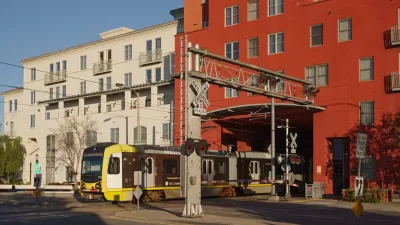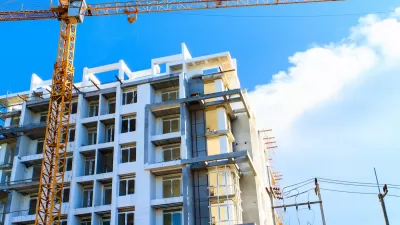The MBTA Communities law sets ‘minimum multi-family unit capacity’ for communities located near transit stations to boost higher-density housing development in transit-rich areas.

Writing in Commonwealth Magazine, Amy Dain explains Massachusetts’ new MBTA Communities law, which requires “cities and towns served by the MBTA (outside of Boston) to zone a district “of reasonable size” for multi-family housing near MBTA stations, where practical.”
Dain describes the measure used by the state to calculate ‘reasonable size,’ what the state calls “minimum multi-family unit capacity” or zoning capacity. “If you draw a zoning district for multi-family housing (defined as buildings with three or more dwelling units) on a municipal zoning map, you can add up how many housing units in multi-family buildings could theoretically and maximally be built on every existing parcel in the district, based on what the zoning allows, regardless of what exists on each parcel or what the market might favor for each parcel. This count yields the zoning capacity of the district for multi-family housing,” Dain writes.
Notably, “Zoning capacity is not a home production goal,” but “a legal envelope of allowed buildings; an estimated count of technically allowed dwelling units.” Requirements for each community will vary based on the type of transit present, existing density, and other factors. “A district that is reasonable in one city or town may not be reasonable in another city or town, the guidelines explain.”
FULL STORY: What the MBTA Communities law means for your town

Alabama: Trump Terminates Settlements for Black Communities Harmed By Raw Sewage
Trump deemed the landmark civil rights agreement “illegal DEI and environmental justice policy.”

Planetizen Federal Action Tracker
A weekly monitor of how Trump’s orders and actions are impacting planners and planning in America.

Why Should We Subsidize Public Transportation?
Many public transit agencies face financial stress due to rising costs, declining fare revenue, and declining subsidies. Transit advocates must provide a strong business case for increasing public transit funding.

Understanding Road Diets
An explainer from Momentum highlights the advantages of reducing vehicle lanes in favor of more bike, transit, and pedestrian infrastructure.

New California Law Regulates Warehouse Pollution
A new law tightens building and emissions regulations for large distribution warehouses to mitigate air pollution and traffic in surrounding communities.

Phoenix Announces Opening Date for Light Rail Extension
The South Central extension will connect South Phoenix to downtown and other major hubs starting on June 7.
Urban Design for Planners 1: Software Tools
This six-course series explores essential urban design concepts using open source software and equips planners with the tools they need to participate fully in the urban design process.
Planning for Universal Design
Learn the tools for implementing Universal Design in planning regulations.
Caltrans
Smith Gee Studio
Institute for Housing and Urban Development Studies (IHS)
City of Grandview
Harvard GSD Executive Education
Toledo-Lucas County Plan Commissions
Salt Lake City
NYU Wagner Graduate School of Public Service





























